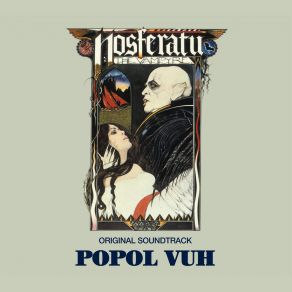Nosferatu (Original Soundtrack)
Download links and information about Nosferatu (Original Soundtrack) by Popol Vuh. This album was released in 1978 and it belongs to Ambient, New Age, Electronica, Rock, Theatre/Soundtrack genres. It contains 14 tracks with total duration of 01:05:28 minutes.

|
|
|---|---|
| Artist: | Popol Vuh |
| Release date: | 1978 |
| Genre: | Ambient, New Age, Electronica, Rock, Theatre/Soundtrack |
| Tracks: | 14 |
| Duration: | 01:05:28 |
| Buy it NOW at: | |
| Buy on iTunes $9.99 | |
Tracks
[Edit]| No. | Title | Length |
|---|---|---|
| 1. | Brüder des Schattens | 5:43 |
| 2. | Höre, der Du wagst | 6:00 |
| 3. | Das Schloss des Irrtums | 5:37 |
| 4. | Die Umkehr | 5:57 |
| 5. | Mantra 1 | 6:15 |
| 6. | Morning Sun | 3:21 |
| 7. | Venus Principle | 4:41 |
| 8. | Mantra 2 | 5:22 |
| 9. | Die Nacht der Himmel | 5:03 |
| 10. | Der Ruf der Rohrflöte | 3:39 |
| 11. | To a little Way | 2:34 |
| 12. | Through Pain to Heaven | 3:47 |
| 13. | On the Way | 4:05 |
| 14. | Zwiesprache der Rohrflöte | 3:24 |
Details
[Edit]Florian Fricke's soundtracks always added a distinctive dimension to the films of Werner Herzog and that's especially true of his recordings for Nosferatu: Phantom der Nacht (starring Klaus Kinski as the most spectacularly grotesque Count Dracula ever). This CD brings together Brüder des Schattens, Söhne des Lichts and Nosferatu: Fantôme de la Nuit, two 1978 Popol Vuh albums containing material for Herzog's film. The director drew initially on the first of these records but subsequently asked Fricke for more music conveying fear and dread. In response, Fricke raided his archive of unused work — this was the origin of the second record. Featured prominently in the film, "Brüder des Schattens, Söhne des Lichts" moves from a spectral choral beginning to a lighter, almost pastoral conclusion with piano, guitar, and sitar, echoing the chiaroscuro dynamic of its title ("Brothers of Shadow, Sons of Light"). That brighter, expansive mood recurs on several tracks with a more pronounced Eastern groove: "Through Pain to Heaven," for example, with its mesmerizing interplay of guitars and droning, billowing sitar. Darker numbers like "Mantra 2" — which combines choral voices and organic drones in a mournful, subtly menacing fashion — resonate more explicitly with the film's gothic aesthetic. Among the dark tracks, the most striking pay homage to early electronic soundtrack experiments: for example, "Die Nacht der Himmel" with its spooky theremin sound and the supremely eerie "Der Ruf der Rohrflöte." To call this a soundtrack CD is slightly misleading: not all the music features in the movie and it omits non-Popol Vuh material heard in the film (portions of Wagner's "Das Rheingold" and Gounod's "Messe Solennelle de Sainte Cècile," for instance). That said, it holds together as a coherent album in its own right and includes some exceptionally strong, memorable material.